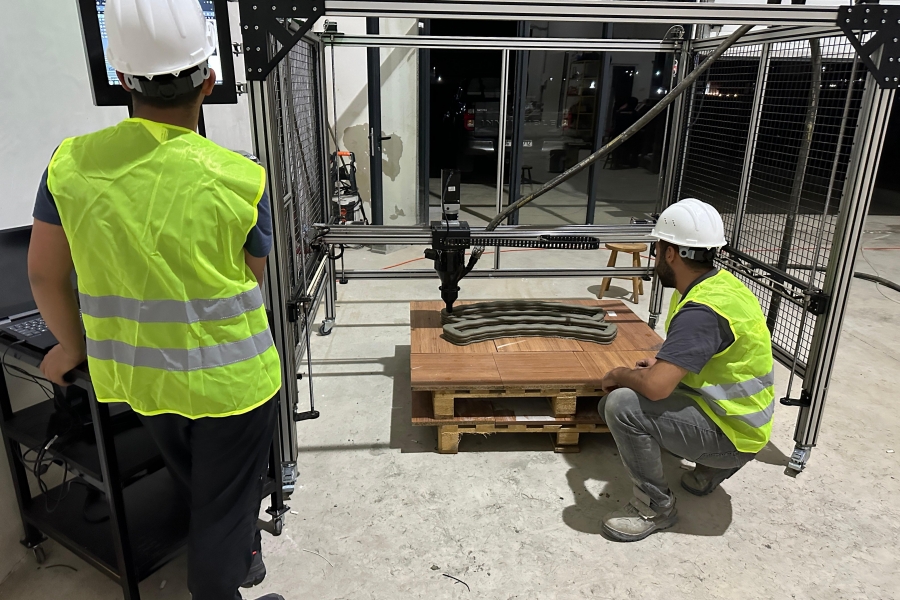Contact Us
Contact us to learn more about our groundbreaking 3D construction printing devices and the high-quality materials compatible with these devices.
- info@confabric.com
- +90 544 872 48 58
- Merkez Ofis:Zafer Mahallesi Şehitler caddesi No:6 TEKMER Çorlu/Tekirdağ Üretim Tesisi:Hatip Mahallesi Tekirdağ Yolu 2.KmTrakya Sanayi Sitesi 3016 Ada 3 Parsel J Blok No:4-9 Çorlu / Tekirdağ

3D Concrete Printing Technology: Revolutionary Innovations in the Construction Industry
The rapid advancement of technology has led to profound changes across various sectors globally. The construction industry is one of the sectors that has been significantly impacted by this transformation, embracing more efficient, faster, and environmentally friendly solutions. Among the most revolutionary technologies is 3D concrete printing, which is transforming construction processes by speeding up construction, reducing costs, and offering sustainable solutions. In this article, we will explore how 3D concrete printing machines work, the innovations they bring to the industry, and the advantages they offer, all while ensuring SEO compatibility.
What is a 3D Concrete Printing Machine?
3D concrete printing machines are advanced devices that use digital designs to construct buildings by depositing layers of concrete. Unlike traditional construction methods, these machines enable detailed planning of structures using Computer-Aided Design (CAD) software. The planned structure is then built layer by layer using concrete mixture by the 3D printer. This technology can be applied in a wide range of structures, from residential homes to commercial buildings.
Advantages of 3D Concrete Printing Machines
Cost Savings
Traditional construction methods often result in material wastage and high labor costs. 3D concrete printing machines use materials much more precisely, minimizing waste. Furthermore, the reduction in human intervention in the construction process leads to significant savings in labor costs. This offers substantial cost savings, especially in large-scale projects.
Faster Construction Process
3D concrete printing technology is much faster than traditional methods. While building a house using traditional methods may take weeks or months, with 3D printing technology, the same structure can be completed in just a few days. This speed is a huge advantage, especially in areas with urgent housing needs.
Environmentally Friendly Solutions
3D concrete printing machines minimize material waste and can work with recyclable materials. This feature is crucial for environmentally conscious construction projects. Additionally, the use of energy-efficient production processes helps reduce the carbon footprint, contributing to sustainable construction practices.
Design Flexibility and Innovative Structures
3D concrete printing technology allows architects and engineers to create much more complex and detailed designs. Structures that would be difficult or impossible to achieve using traditional methods can be easily constructed with 3D printers. This opens the door to more creative and unique buildings, both aesthetically and functionally.
More Durable Structures
Structures built with 3D concrete printing machines are stronger and more durable due to the layered production technique. The homogeneous application of concrete and strong bonds between the layers ensure the longevity of the buildings. This contributes to the structures being more resistant to earthquakes and other natural disasters.
How 3D Concrete Printing is Transforming the Construction Industry
Automation in Construction
3D concrete printing technology significantly reduces human intervention, automating the construction process. This helps minimize construction errors and accelerates project completion. Automation also leads to more precise and error-free production.
Cost Efficiency and Productivity
3D printing machines reduce the amount of material used in construction, which significantly lowers costs. Material waste is virtually eliminated, and the materials used are optimized for efficiency. This provides significant cost savings in both small and large-scale construction projects.
Reduced Labor Requirements
Traditional construction methods require a large workforce, while 3D concrete printing machines can complete construction processes with far less labor. This is particularly advantageous in regions where labor is limited. Additionally, this contributes to reducing workplace accidents.
The Future of 3D Concrete Printing
It is expected that 3D concrete printing machines will become more widespread in the construction industry in the future. This technology will play a significant role in areas where there is a high demand for emergency housing and in sustainable construction projects. Moreover, the integration of technologies such as Artificial Intelligence (AI) and Machine Learning will further enhance the efficiency and innovation of 3D printing in construction.
The Impact of 3D Concrete Printing on the Construction Industry
3D concrete printing machines offer revolutionary innovations in the construction industry. This technology not only provides cost savings but also speeds up construction processes and offers environmentally friendly solutions. With durable structures, design flexibility, and enhanced efficiency, 3D concrete printing is set to play a key role in future construction projects. The reduction in costs, acceleration of processes, and increased design flexibility clearly demonstrate why 3D concrete printing technology is considered the future of construction. If you would like to learn more about 3D concrete printing machines and our high-quality materials compatible with these devices, please feel free to contact us.